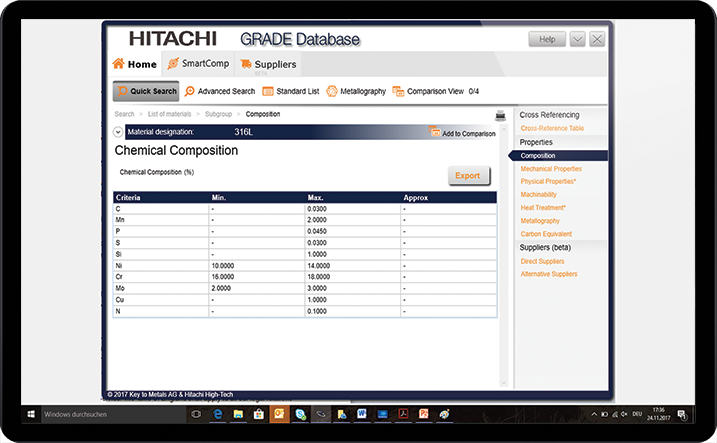Increasing demand for imported metals, varying attitudes to metal quality by country, new metal production techniques and keen competition are driving down metal prices. As a consequence, in some cases quality has suffered. For example, steel used to have a much higher nickel content. Practices like adding low cost elements to steel, such as boron, are the cheapest ways to make alloyed steel. However, too much boron can reduce weldability and cause cracking. Used in the construction of a bridge, the results could be catastrophic. That’s why we know the importance of having a comprehensive metals grade reference database as part of your analysis toolkit.

Changing attitudes and understanding
A few hundred years ago, just 12 types of metal were known. Today, there are more than 3,500 distinctive materials in the steel industry alone. There are also in excess of 350,000 metal grades, defined by different national standards, in more than 15 million variations, for 74 designations. ASTM, AISI, EN, DIN, BS, JIS and GOST standards are the tip of the iceberg. It’s no wonder, therefore, that understanding metal and its grading has become a time-consuming and expensive part of metal production and manufacturing.
With manufacturers now producing a vast range of metals, quality assurance and control standards have to be more robust. Analysis of materials coming in and products going out is a vitally important safeguard for anyone using metal in their manufacturing process. Even the output of 3D metal printing, will only be as good as the raw input allows, however clever it may be. This will make grading an essential part of the process.
Time and cost saving
Metals analyzers are crucial to the determination of a metal’s chemical composition, which, together with mechanical and physical properties, is critical in determining quality and suitability. Analyzing metal on its way in, on its way out, and anywhere in between during the production process, is an essential part of the vigilance required to meet quality standards. Keeping up with the current plethora of standards and knowing their equivalents manually can be a timely and costly nightmare. So, too, is finding which grade is correct by application.
In many companies, engineers have to search manually to discover what metals they require for particular applications. Hours can be spent deliberating over information on heat treatment, weldability and machinability, delaying projects while the costs mount. In addition, human error inherent in any complicated data input can yield incorrect results, which cost heavily in wasted time and materials, delays, reputation and customer retention – not to mention compensation should products cause damage and fatalities.
Why use a grade database?
As the metals industry becomes more complicated, an all-encompassing metal grade database is an increasingly desirable tool. In addition to metal identification, it can also assist with:
At Hitachi High-Tech, we offer a wide range of metals analyzers. The largest globally available metal GRADE Database comes pre-installed on all Hitachi High-Tech optical emissions spectrometers (OES) and is available for the X-MET8000 handheld XRF (X-ray fluorescence) analyzers as an optional extra. Use our free 60 day trial to convince yourself of the efficiency.
FREE 60 day trial
Removing the need for researching grade catalogues, the database facilitates worldwide searches by specific chemical composition or mechanical properties in just a few easy steps. This enables you to easily decipher metal specifications and find the correct grade for a specific application, confident that the database is correct and up to date with worldwide grading standards.
Contact us to find out how you could benefit from our GRADE Database or book a demo to learn more about our analyzers.
Contact UsYou might also be interested in:
Our full range of spark OES instruments
View an on-demand spark OES demo
Book a 1:1 live demo